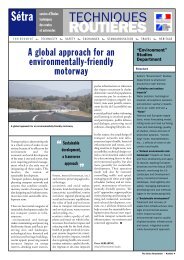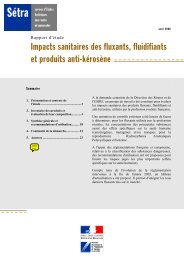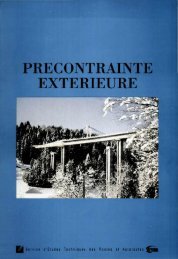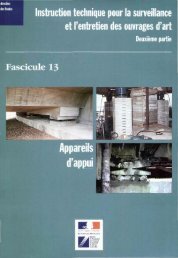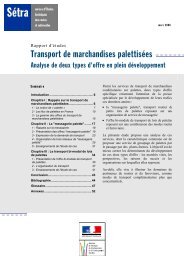Transports intelligents Mise en Åuvre de la directive 2010/40=
Transports intelligents Mise en Åuvre de la directive 2010/40=
Transports intelligents Mise en Åuvre de la directive 2010/40=
You also want an ePaper? Increase the reach of your titles
YUMPU automatically turns print PDFs into web optimized ePapers that Google loves.
<strong>Transports</strong> <strong>intellig<strong>en</strong>ts</strong><strong>Mise</strong> <strong>en</strong> œuvre <strong>de</strong> <strong>la</strong> <strong>directive</strong> <strong>2010</strong>/40 pour <strong>la</strong> pério<strong>de</strong> 2012 - 2017 – Rapport d'étu<strong>de</strong>sCes « bouquets phares » prés<strong>en</strong>t<strong>en</strong>t une certaine cohér<strong>en</strong>ce du point <strong>de</strong> vue <strong>de</strong>s att<strong>en</strong>tes <strong>de</strong>s usagers. Cep<strong>en</strong>dant,ils recouvr<strong>en</strong>t <strong>de</strong>s services d’information qui peuv<strong>en</strong>t se distinguer nettem<strong>en</strong>t les uns <strong>de</strong>s autres du point <strong>de</strong> vue<strong>de</strong>s architectures sous-jac<strong>en</strong>tes (notamm<strong>en</strong>t <strong>la</strong> répartition <strong>de</strong>s rôles dans <strong>la</strong> production et <strong>la</strong> qualification <strong>de</strong> <strong>la</strong>donnée, et <strong>de</strong>s conseils <strong>de</strong> comportem<strong>en</strong>ts attachés). L’annexe 2 prés<strong>en</strong>te une analyse plus détaillée <strong>de</strong>sdiffér<strong>en</strong>ts services d’information <strong>en</strong> fonction <strong>de</strong>s <strong>en</strong>jeux <strong>de</strong> qualité.De plus, <strong>la</strong> mise <strong>en</strong> avant <strong>de</strong> « bouquets phares » <strong>de</strong>vrait naturellem<strong>en</strong>t s’accompagner d’une priorisation <strong>de</strong>sréseaux sur lesquels ils serai<strong>en</strong>t déployés. En effet, les <strong>en</strong>jeux <strong>de</strong> congestion, <strong>de</strong> sécurité et d’<strong>en</strong>vironnem<strong>en</strong>tpourrai<strong>en</strong>t justifier <strong>de</strong> différ<strong>en</strong>cier les segm<strong>en</strong>ts <strong>de</strong> réseaux, pour t<strong>en</strong>ir compte notamm<strong>en</strong>t <strong>de</strong>s coûtsd’acquisition et <strong>de</strong> qualification <strong>de</strong> <strong>la</strong> donnée. Cette analyse reste à conduire, <strong>en</strong> s’inspirant notamm<strong>en</strong>t <strong>de</strong>stravaux sur les <strong>en</strong>vironnem<strong>en</strong>ts d’exploitation <strong>en</strong>gagés par EasyWay.Cep<strong>en</strong>dant, il convi<strong>en</strong>t ici <strong>de</strong> t<strong>en</strong>ir compte <strong>de</strong> ce que l’usager <strong>de</strong>vra avoir une vision simple <strong>de</strong>s réseaux surlesquels il peut s’att<strong>en</strong>dre à disposer <strong>de</strong>s différ<strong>en</strong>ts services d’information, notamm<strong>en</strong>t <strong>en</strong> temps réel : le pireserait <strong>de</strong> <strong>la</strong>isser croire à l’usager qu’il bénéficie d’un service, notamm<strong>en</strong>t d’alertes <strong>de</strong> sécurité, alors que celles-cine sont pas, <strong>en</strong> fait, disponibles, ce qui pourrait conduire à <strong>de</strong>s effets pervers d’hypovigi<strong>la</strong>nce vis à vis <strong>de</strong>sdispositifs embarqués, voire <strong>de</strong> rejet <strong>de</strong> l’information embarquée.Aussi, les <strong>en</strong>jeux <strong>de</strong>vront être appréciés dans <strong>la</strong> construction <strong>de</strong> ces services ou <strong>de</strong> ces bouquets, pour ce quiconcerne le réseau routier national, au travers d’<strong>en</strong>vironnem<strong>en</strong>ts d’exploitation simples et, si possible,par<strong>la</strong>nts pour l’usager. L’idée à creuser serait <strong>de</strong> ret<strong>en</strong>ir trois niveaux <strong>de</strong> réseaux :• le réseau c<strong>en</strong>tral du RTE – T 9• le réseau complet urbain du RTE – T• le réseau complet inter-urbain du RTE – TLa démarche <strong>en</strong>visagée consiste :• à établir une stratégie d’information routière sur le réseau routier national, sur <strong>la</strong> base <strong>de</strong>s élém<strong>en</strong>tspréliminaires ci-<strong>de</strong>ssus ;• à mettre à disposition <strong>de</strong>s gestionnaires (notamm<strong>en</strong>t locaux) une métho<strong>de</strong> d’id<strong>en</strong>tification <strong>de</strong>s niveaux <strong>de</strong>service adaptés aux différ<strong>en</strong>ts <strong>en</strong>vironnem<strong>en</strong>ts d’exploitation ;• à mettre à disposition <strong>de</strong>s acteurs les architectures qui auront été id<strong>en</strong>tifiées comme nécessaires audéveloppem<strong>en</strong>t <strong>de</strong> ces services, sans freiner l’innovation ;• à mettre à disposition <strong>de</strong>s acteurs <strong>de</strong>s états <strong>de</strong> <strong>la</strong> connaissance sur les comportem<strong>en</strong>ts <strong>de</strong>s usagers face àl’information, notamm<strong>en</strong>t <strong>en</strong> matière <strong>de</strong> sécurité (cf. ci-<strong>de</strong>ssous sur l’évaluation)• à mettre à disposition <strong>de</strong>s acteurs <strong>de</strong>s référ<strong>en</strong>tiels <strong>de</strong> qualité qui auront été id<strong>en</strong>tifiés comme nécessaires aurespect <strong>de</strong>s objectifs <strong>de</strong> circu<strong>la</strong>tion, <strong>de</strong> sécurité et d’<strong>en</strong>vironnem<strong>en</strong>t.Cas <strong>de</strong>s services d’information multimodale(SIM)En complém<strong>en</strong>t aux services d’information routière, <strong>de</strong>s ori<strong>en</strong>tations se dégag<strong>en</strong>t concernant les servicesd’information multimodale, qui pourrai<strong>en</strong>t :• Au niveau du périmètre modal :– avoir comme périmètre initial l’offre <strong>de</strong> transports publics.– développer l’information routière et les interfaces avec <strong>la</strong> route (P+R) (cf. ci-<strong>de</strong>ssus)– pr<strong>en</strong>dre <strong>en</strong> compte les nouveaux services <strong>de</strong> mobilité• Au niveau géographique :– offrir à terme une information <strong>de</strong> porte à porte dépassant les frontières du SIM avec un périmètre soit interrégional,soit national9 Réseau TransEuropé<strong>en</strong> <strong>de</strong> <strong>Transports</strong>Collection « Les rapports » – Sétra – 21 – août 2012




